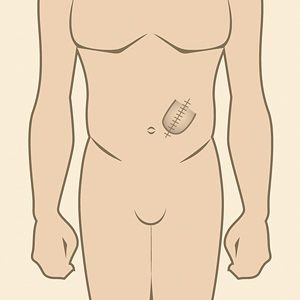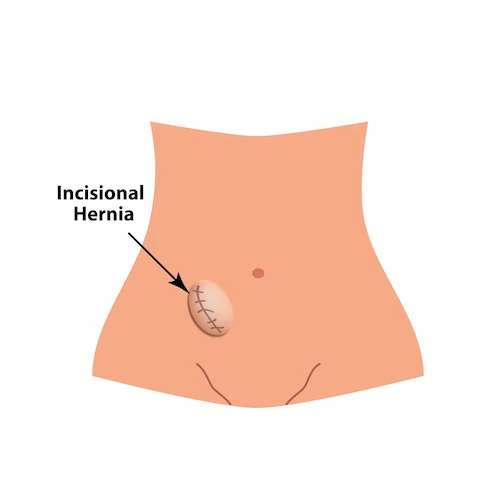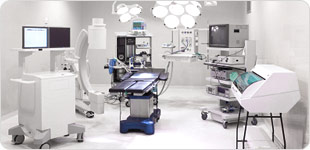Incisional/Ventral Hernia

An incisional hernia is hole within the site of an earlier surgical incision.
Ventral hernias or incisional hernias can occur in men, women or children, and they occur along the midline of the abdomen. They frequently occur at the point of a prior incision, if you have had an abdominal surgery procedure in the past. The hernia surgeons at Hernia Center Los Angeles specialize in the diagnosis and treatment of incisional hernias and ventral hernias.
- What is an Incisional Hernia?
- Causes of Incisional/Ventral Hernias
- What are the Symptoms of an Incisional Hernia?
- Preparing for Incisional Hernia Repair
- Incisional Hernia Treatment
- Recovery After Incisional Hernia Surgery
- Frequently Asked Questions About Ventral Hernias
What is an Incisional Hernia?
A ventral hernia or incisional hernia is a hole in the abdominal wall behind or within the site of an earlier surgical incision. Because of the hole, the contents of the abdominal cavity, such as intestines, can spill out behind the skin, creating a bulge.

Causes of Incisional/Ventral Hernias
Sometimes, ventral hernias can occur naturally, through areas of the abdominal wall which may be naturally weaker, or strained and pulled by pregnancy. If you have had prior surgery, then the fascia (connective tissue), which is the strength component of the abdominal wall, may have healed poorly.
This can happen for many reasons. The most common reason is infection after the surgery. Other risk factors can also lead to a hernia, including:
- Extensive coughing
- Heavy lifting
- Diabetes
- Obesity
- Returning to normal activity too soon after surgery
- A physical tendency that predisposes some patients to develop hernias1
What are the Symptoms of an Incisional Hernia?
Symptoms of an incisional or ventral hernia may include:
- A bulge in the abdomen, which may be painful
- Constipation
- Nausea and/or vomiting
- Fever
- Elevated heart rate2
Preparing for Incisional Hernia Repair
If you have been diagnosed with a ventral or incisional hernia, the first step in preparing for treatment is to attend a consultation with a hernia doctor from Hernia Center Los Angeles. Your doctor will conduct a physical examination and review of your medical history, and may also order imaging tests such as X-ray, CT scan, or ultrasound. You will be fully educated about your condition and treatment options, and will be able to ask questions before your procedure is scheduled. You will also receive detailed instructions about the preparation and recovery period for your hernia repair.
Incisional Hernia Treatment
Ventral hernia repair is a common procedure, with roughly 350,000 incisional hernia operations occurring in the United States each year.3 The surgical technique used for ventral hernia repair depends on the extent of the hernia.
Ventral hernias may be simple, such as just a small hole in the abdominal fascia. In this case, our surgeons recommend repairing the hernia by returning the bowel to its proper location, and then closing the hole in the abdominal wall. In many cases, an underlay mesh is used, which is placed to remove tension from the abdominal wall during closure. This gives the abdominal wall a chance to heal well in a tension-free environment, which is the key to a successful outcome.
Sometimes, patients with a ventral hernia have an underlying condition called “rectus diastasis” or abdominal muscle separation. This can occur in both men and women, but is especially common after pregnancy. The muscles on either side of your abdomen -- the ones that make up your “six pack” are called the rectus muscles. They normally join at your midline, adjacent to your navel. These muscles can separate or stretch apart, called a diastasis. You can tell you have a rectus diastasis because you will notice your abdomen bulges easily after meals, it is difficult to “suck it in”, and your abdominal strength is reduced.
If your ventral hernia includes rectus diastasis, your surgeon will repair your abdominal muscles at the same time as your hernia repair to decrease the likelihood of hernia recurrence.
Recovery After Incisional Hernia Surgery
The recovery period after incisional hernia repair is different for each patient, depending partially on the extent of the repair required. In general, you can expect some pain following your hernia surgery. Your hernia doctor will prescribe pain medication to help you stay comfortable.
You will need to rest and limit your activities for at least one week after your ventral hernia repair, and you will be instructed to avoid heavy lifting for some time. Your surgeon will let you know when you are able to get back to exercise and other strenuous activities during a follow-up visit.
Frequently Asked Questions About Ventral Hernias
How is an incisional hernia diagnosed?
The first diagnostic test for a ventral hernia is a visual and physical examination. Your doctor may ask you to cough or strain, which often makes the hernia protrude more significantly. You may also undergo a number of imaging tests, such as CT scan, ultrasound, and X-ray.
Is surgery necessary for a ventral hernia?
Patients often ask, “Can I just leave an incisional hernia alone?” Unfortunately, the only way to repair a ventral or incisional hernia is surgery. In fact, if a ventral hernia is not treated properly, it can lead to serious health complications.
Should I have a mesh repair for my ventral hernia repair?
You may have heard of a “mesh” hernia repair, or know someone who has gotten one. While surgical mesh is an excellent surgical tool for some types of hernia repairs, our hernia surgeons recommend mesh only if it is necessary to add strength to the repair.
What if my child has a ventral hernia?
If your child develops a ventral hernia, you should get it repaired promptly. Ventral hernias do not close on their own. The longer that your child's hernia remains, the more dangerous it becomes. If a portion of your child's bowel slips through the hole in the abdominal wall and becomes trapped, it can lead to a bowel obstruction and require emergency surgery.
In a child, the procedure for repairing a ventral hernia is usually very simple. The hole is closed with sutures, and the abdominal muscles grow back together as the child grows.
Contact Us
If you have been diagnosed with a ventral or incisional hernia, contact the hernia doctors at Hernia Center Los Angeles to schedule a consultation and learn more about your treatment options.
1 Cleveland Clinic. What is a Ventral Hernia? Available: https://my.clevelandclinic.org/health/diseases/16531-ventral-hernia. Accessed April 19, 2023.2 Johns Hopkins Medicine. Ventral (Abdominal) Hernia. Available: https://www.hopkinsmedicine.org/health/conditions-and-diseases/hernias/ventral-abdominal-hernia. Accessed April 19, 2023.
3 Smith J, Parmely JD. Ventral Hernia. [Updated 2022 Aug 8]. In: StatPearls [Internet]. Treasure Island (FL): StatPearls Publishing; 2023 Jan-. Available: https://www.ncbi.nlm.nih.gov/books/NBK499927. Accessed April 19, 2023.



